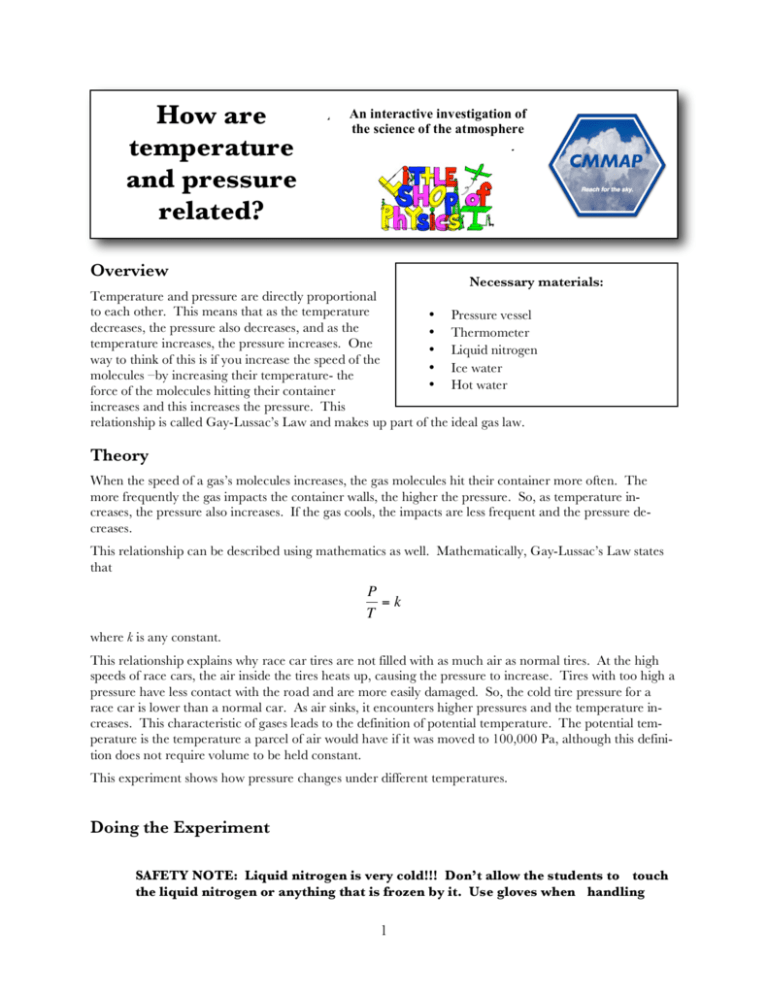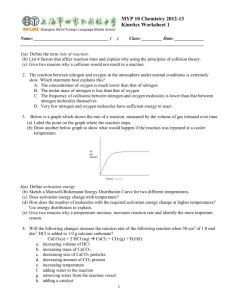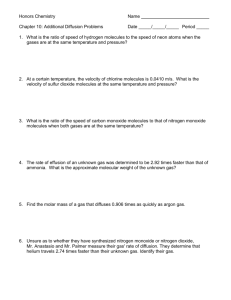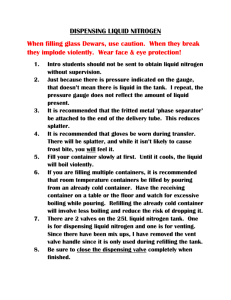How are temperature and pressure related?
advertisement

How are temperature and pressure related? An interactive investigation A laboratory experiment fromofthe the science of of thePhysics atmosphere Little Shop at Colorado State University Overview Necessary materials: Temperature and pressure are directly proportional to each other. This means that as the temperature • Pressure vessel decreases, the pressure also decreases, and as the • Thermometer temperature increases, the pressure increases. One • Liquid nitrogen way to think of this is if you increase the speed of the • Ice water molecules –by increasing their temperature- the • Hot water force of the molecules hitting their container increases and this increases the pressure. This relationship is called Gay-Lussac’s Law and makes up part of the ideal gas law. Theory When the speed of a gas’s molecules increases, the gas molecules hit their container more often. The more frequently the gas impacts the container walls, the higher the pressure. So, as temperature increases, the pressure also increases. If the gas cools, the impacts are less frequent and the pressure decreases. This relationship can be described using mathematics as well. Mathematically, Gay-Lussac’s Law states that P =k T where k is any constant. This relationship explains why race car tires are not filled with as much air as normal tires. At the high speeds of race cars, the air inside the tires heats up, causing the pressure to increase. Tires with too high a pressure have less contact with the road and are more easily damaged. So, the cold tire pressure for a race car is lower than a normal car. As air sinks, it encounters higher pressures and the temperature increases. This characteristic of gases leads to the definition of potential temperature. The potential temperature is the temperature a parcel of air would have if it was moved to 100,000 Pa, although this definition does not require volume to be held constant. This experiment shows how pressure changes under different temperatures. Doing the Experiment SAFETY NOTE: Liquid nitrogen is very cold!!! Don’t allow the students to touch the liquid nitrogen or anything that is frozen by it. Use gloves when handling 1 anything frozen by liquid nitrogen. If you do touch some liquid nitrogen, run your skin under warm water. The experiment goes like this: • Measure the temperature (in Kelvin) and pressure (in Pascals) at room temperature and record in a table. • Next, do the same with the hot water. • Measure and record the temperature and pressure of the ice water. • Measure the pressure when the pressure vessel is dipped in liquid nitrogen. Liquid nitrogen boils at 77 K (-196°C/321°F). If your thermometer does not measure temperatures that low, record this temperature. Temperature Pressure (K) (Pa) Liquid Nitrogen Ice Water Room Temperature Hot Water What do you notice happens to the pressure as the temperature changes? Sea level is around 100,000 Pa. What temperature do you think the air would need to be in order to have this pressure? The pressure on Mount Everest is around 30,000 Pa and the highest pressure ever recorded was in Mongolia at 108,500 Pa. What would be the temperature difference if the air you measured today was moved to these two locations? The reason the observed temperatures do not reach these extremes is because in nature the volume is not held constant. The volume of the gas expands and contracts to counter the changes in temperature. Summing Up This exercise is a quick example of how pressure and temperature change together. Gay-Lussac’s Law is one part of the ideal gas law and so explains how gases change when volume is held constant. As the temperature increases, the molecules in the gas move faster, impacting the gas’s container more frequently and exerting a greater force. This increases the pressure. For More Information CMMAP, the Center for Multi-Scale Modeling of Atmospheric Processes: http://cmmap.colostate.edu Little Shop of Physics: http://littleshop.physics.colostate.edu 2








